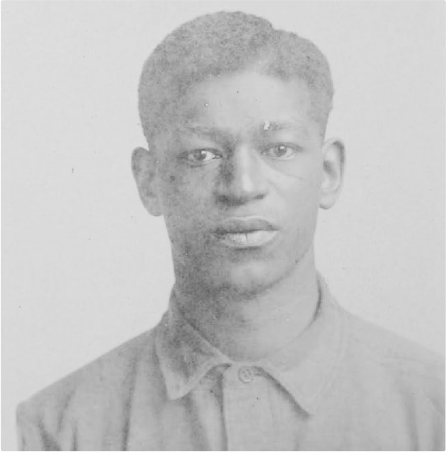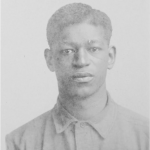PFC. Henry Lee Chenault
Henry Lee Chenault was born in Kentucky in 1892 or 1895. He quit school at sixteen when he was in the fifth grade and worked as a stable hand and teamster. Records indicate he enlisted in I Co, 3/24 Infantry, in February 1913, but his wife cited a different enlistment date and said his first enlistment was served in the 25th Infantry. He was one of the few married men in the battalion, and his prison evaluation file noted, “His wife states that he was a good husband and always supported her as best he could.” He was court-martialed in the third trial and was sentenced to death, but that sentence was commuted to life after Secretary Baker’s intervention.
On June 13, 1919, Chenault’s wife (she did not sign her first name) wrote a letter to the JAG asking for clemency on his behalf:
“Red Bluff, Cal June 13, 1919 Judge Advocate General U.S.A. Washington, D.C. Dear Sir: I am writing you in regard to my husband who is confined in Leavenworth prison. I wrote to the auditor of the war department and they stated in their letter to me for me to write to Judge Advocate General, USA Washington D.C. and stated the place time and
charges and give his full name and service. And that you would inform me if it was any way he could be released. He was in Houston Texas the home of the riot in the month of August 1917. He was sent to Leavenworth prison September 1918 for life. His full name is Henry lee Chenault. His first enlistment was the 5 Inf 1913 [she might have meant ‘25th Inf,’]. And he was called back to the 24th in 1917, May 24th. He was then in the 24th Inf. four months before the riot. I have a little child and haven’t any support and I am now living with my mother at the present. So I would like to know if there is anything could be done to get him out.” She signed her name as “Mrs. Henry Lee Chenault.”
The Acting Judge Advocate replied in a letter explaining the government’s position on the matter, concluding, “It is, of course, much to be regretted that your husband, by his conduct, has brought upon himself the penalties of the law, but in view of the facts disclosed by the evidence in his case, clemency cannot consistently be recommended – certainly not at this time.”
When his case was reviewed by the clemency board in April 1919, the examiner wrote in the Remarks section, “This man appears a good average type of negro, might well be considered for restoration were it not for the crime for which he is now serving sentence.” Clearly the racial bias continued from the prosecution and sentencing on through the clemency process.
Chenault was denied clemency in June 1919 and August 1922, and was reported to have committed three minor infractions of three violations of prison regulations, but over-all his conduct in confinement was excellent. In 1924 it was recommended that his sentence be remitted to twenty years. In 1931 he was still incarcerated, and at that time the clemency board determined that no further extension of clemency was warranted at that time.
Henry Lee Chenault died on January 14, 1969.


